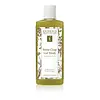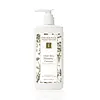What's inside
What's inside
 Key Ingredients
Key Ingredients

 Benefits
Benefits

 Concerns
Concerns

 Ingredients Side-by-side
Ingredients Side-by-side

Aloe Barbadensis Leaf Juice
Skin ConditioningCitrus Limon Fruit Extract
MaskingLycium Barbarum Fruit Extract
AstringentJasminum Sambac Flower Extract
MaskingLavandula Angustifolia Flower Extract
CleansingCalendula Officinalis Flower Extract
MaskingOryza Sativa Extract
AbsorbentCamellia Sinensis Leaf Extract
AntimicrobialRosmarinus Officinalis Leaf Extract
AntimicrobialGlycine Soja Extract
Skin ConditioningGlycerin
HumectantCellulose Gum
Emulsion StabilisingCitric Acid
BufferingCoco-Betaine
CleansingSodium Cocoyl Isethionate
CleansingDecyl Glucoside
CleansingPolyglyceryl-10 Caprylate/Caprate
EmulsifyingCoco-Glucoside
CleansingGlyceryl Oleate
EmollientXanthan Gum
EmulsifyingMoonstone Extract
Skin ConditioningMalpighia Emarginata Fruit Extract
Skin ConditioningPhyllanthus Emblica Fruit Extract
HumectantAdansonia Digitata Seed Oil
EmollientCamphor
MaskingDaucus Carota Sativa Root Extract
Skin ConditioningCocos Nucifera Water
MaskingTapioca Starch
Thioctic Acid
AntioxidantLimnanthes Alba Seed Oil
Skin ConditioningEthylhexylglycerin
Skin ConditioningAnthemis Nobilis Flower Extract
MaskingButyrospermum Parkii Butter
Skin ConditioningAloe Barbadensis Leaf Juice, Citrus Limon Fruit Extract, Lycium Barbarum Fruit Extract, Jasminum Sambac Flower Extract, Lavandula Angustifolia Flower Extract, Calendula Officinalis Flower Extract, Oryza Sativa Extract, Camellia Sinensis Leaf Extract, Rosmarinus Officinalis Leaf Extract, Glycine Soja Extract, Glycerin, Cellulose Gum, Citric Acid, Coco-Betaine, Sodium Cocoyl Isethionate, Decyl Glucoside, Polyglyceryl-10 Caprylate/Caprate, Coco-Glucoside, Glyceryl Oleate, Xanthan Gum, Moonstone Extract, Malpighia Emarginata Fruit Extract, Phyllanthus Emblica Fruit Extract, Adansonia Digitata Seed Oil, Camphor, Daucus Carota Sativa Root Extract, Cocos Nucifera Water, Tapioca Starch, Thioctic Acid, Limnanthes Alba Seed Oil, Ethylhexylglycerin, Anthemis Nobilis Flower Extract, Butyrospermum Parkii Butter
Cucumis Melo Juice
SoothingSalix Alba Bark Extract
AstringentRosa Canina Fruit Extract
AstringentHydrolyzed Grape Fruit Extract
HumectantSymphytum Officinale Leaf Extract
Skin ConditioningLavandula Angustifolia Flower Extract
CleansingEquisetum Arvense Extract
AstringentMentha Piperita Leaf Extract
Skin ConditioningCalendula Officinalis Flower Extract
MaskingGlycine Max Root Extract
Skin ConditioningSweet Almond Amino Acids
HumectantLauryl Glucoside
CleansingBenzyl Alcohol
PerfumingSalicylic Acid
MaskingGlycerin
HumectantSorbic Acid
PreservativeYogurt
Skin ProtectingCucumis Sativus Fruit Extract
EmollientCitric Acid
BufferingMenthol
MaskingMelaleuca Alternifolia Leaf Oil
AntioxidantCitrus Limon Fruit Extract
MaskingMalpighia Emarginata Fruit Extract
Skin ConditioningPhyllanthus Emblica Fruit Extract
HumectantAdansonia Digitata Seed Oil
EmollientCamphor
MaskingDaucus Carota Sativa Root Extract
Skin ConditioningCocos Nucifera Water
MaskingLycium Barbarum Fruit Extract
AstringentTapioca Starch
Thioctic Acid
AntioxidantCucumis Melo Juice, Salix Alba Bark Extract, Rosa Canina Fruit Extract, Hydrolyzed Grape Fruit Extract, Symphytum Officinale Leaf Extract, Lavandula Angustifolia Flower Extract, Equisetum Arvense Extract, Mentha Piperita Leaf Extract, Calendula Officinalis Flower Extract, Glycine Max Root Extract, Sweet Almond Amino Acids, Lauryl Glucoside, Benzyl Alcohol, Salicylic Acid, Glycerin, Sorbic Acid, Yogurt, Cucumis Sativus Fruit Extract, Citric Acid, Menthol, Melaleuca Alternifolia Leaf Oil, Citrus Limon Fruit Extract, Malpighia Emarginata Fruit Extract, Phyllanthus Emblica Fruit Extract, Adansonia Digitata Seed Oil, Camphor, Daucus Carota Sativa Root Extract, Cocos Nucifera Water, Lycium Barbarum Fruit Extract, Tapioca Starch, Thioctic Acid
 Reviews
Reviews

Ingredients Explained
These ingredients are found in both products.
Ingredients higher up in an ingredient list are typically present in a larger amount.
Baobab seed oil is an emollient. It is rich in fatty acids and vitamins A, E, and D.
The fatty acid content of this oil is roughly 30-40% oleic acid, 24-34% linoleic acid, and 18-30% palmitic acid. This gives it skin hydrating and nourishing properties.
Due to this fatty acid content, this ingredient may not be fungal-acne safe.
Fun fact: Our skin uses fatty acids, and especially linoleic acid, for creating ceramides.
Learn more about Adansonia Digitata Seed OilCalendula Officinalis Flower Extract comes from the common Marigold plant. This ingredient is a skin conditioner.
Marigolds contain flavonoids. Flavonoids are a group of substances found naturally in plants. They possess antioxidant and inflammation properties.
This ingredient soothes skin inflammation by inhibiting inhibiting a part of the inflammation process.
Marigolds have been used in traditional medicine throughout Asia and Europe.
Learn more about Calendula Officinalis Flower ExtractCamphor is a waxy solid with a strong scent. It is made using turpentine oil.
This ingredient is used for medicinal purposes due to its cooling effect. In medicine, camphor is a common anti-inflammation ingredient.
Camphor also possesses antibacterial and antifungal properties.
One study found camphor to be a potential anti-wrinkle ingredient. This might be due to its ability to increase elastin and collagen production. Collagen and elastin are responsible for plump and youthful looking skin.
It is best to use cosmetics with a small amount of camphor under 11%. Using topical camphor may induce irritation and redness.
In the past, camphor was traditionally made by distilling the wood of the camphor tree.
Learn more about CamphorCitric Acid is an alpha hydroxy acid (AHA) naturally found in citrus fruits like oranges, lemons, and limes.
Like other AHAs, citric acid can exfoliate skin by breaking down the bonds that hold dead skin cells together. This helps reveal smoother and brighter skin underneath.
However, this exfoliating effect only happens at high concentrations (20%) which can be hard to find in cosmetic products.
Due to this, citric acid is usually included in small amounts as a pH adjuster. This helps keep products slightly more acidic and compatible with skin's natural pH.
In skincare formulas, citric acid can:
While it can provide some skin benefits, research shows lactic acid and glycolic acid are generally more effective and less irritating exfoliants.
Most citric acid used in skincare today is made by fermenting sugars (usually from molasses). This synthetic version is identical to the natural citrus form but easier to stabilize and use in formulations.
Read more about some other popular AHA's here:
Learn more about Citric AcidCitrus Limon Fruit Extract comes from lemons. While lemon extract is exfoliating and antimicrobial, it can also cause skin sensitivity.
Lemons contains antioxidants, which may help with anti-aging. They are also rich in citric acid, an AHA.
And of course, lemons are rich in Vitamin C. Vitamin C helps with skin-brightening and increasing collagen production.
The acidity of lemons may work as an astringent for acne.
However, lemons can also cause skin sensitivity due to its limonene content. It can also increase photosensitivity, or sensitivity to the sun.
This ingredient is also used to add a lemon scent to products.
Learn more about Citrus Limon Fruit ExtractDaucus Carota Sativa Root Extract comes from the root commonly known as carrot (the orange kind we eat!).
This extract contains beta-carotene, a pigment responsible for giving plants the orange color. Beta-carotene is a potent antioxidant. Antioxidants may help reduce the signs of aging.
Beta-carotene is the reason we turn orange if we eat too many carrots.
It should be noted coming into contact with the leaves of wild carrots can cause skin irritation. The sap causes phytophotodermatitis, or sensitivity exposed to sunlight.
This ingredient is created using the edible parts of the carrot.
Learn more about Daucus Carota Sativa Root ExtractGlycerin is already naturally found in your skin. It helps moisturize and protect your skin.
A study from 2016 found glycerin to be more effective as a humectant than AHAs and hyaluronic acid.
As a humectant, it helps the skin stay hydrated by pulling moisture to your skin. The low molecular weight of glycerin allows it to pull moisture into the deeper layers of your skin.
Hydrated skin improves your skin barrier; Your skin barrier helps protect against irritants and bacteria.
Glycerin has also been found to have antimicrobial and antiviral properties. Due to these properties, glycerin is often used in wound and burn treatments.
In cosmetics, glycerin is usually derived from plants such as soybean or palm. However, it can also be sourced from animals, such as tallow or animal fat.
This ingredient is organic, colorless, odorless, and non-toxic.
Glycerin is the name for this ingredient in American English. British English uses Glycerol/Glycerine.
Learn more about GlycerinLavandula Angustifolia Flower Extract comes from the lavender plant.
Many components of lavender flowers are antioxidants, such as ferulic acid, caffeic acid, and several flavonoids.
Traditional Iranian folk medicine uses Lavender extract to help treat inflammation.
Lavender extract may have a scent.
It contains linalool, a known allergen. However, lavender extract contains less linalool than lavender essential oil.
Learn more about Lavandula Angustifolia Flower ExtractLycium Barbarum Fruit Extract comes from the Goji Berry. Goji berries are native to China and can be found across Eurasia.
Goji berries contain polysaccharides, carotenoids and flavonoids. Antioxidants help your body fight off free-radical molecules. These molecules are unstable and may damage your skin. By making free-radicals more stable, antioxidants can help with anti-aging.
Polysaccharides help hydrate the top layer of skin due to its ability to mimic natural carbohydrates.
Learn more about Lycium Barbarum Fruit ExtractThis ingredient is also known as acerola or barbados cherry. It is rich in antioxidants and polysaccharides, giving it skin protecting and hydrating properties.
This ingredient is also known as Indian Gooseberry. It is skin hydrating and antioxidant rich.
Tapioca starch is a thickening agent and is made from the cassava root, also known as yucca.
According to a manufacturer, it is an excellent talc replacement.
It is gluten-free.
Learn more about Tapioca StarchThioctic Acid is an enzyme and antioxidant. A more common name for this is Alpha Lipoic Acid.
Alpha Lipoic Acid can be naturally found in the mitochondria of every cell.
Antioxidants help fight free-radicals. Free-radicals are molecules that may damage your skin cells. The antioxidants in Alpha Lipoic Acid have been shown to fight damage from cigarette smoke.
Studies also show Alpha Lipoic Acid plays a role in wound healing.
Thioctic Acid will break down when exposed to sunlight.
Many foods contain thioctic acid, including tomato, brussel sprouts, spinach, and broccoli.
Learn more about Thioctic Acid